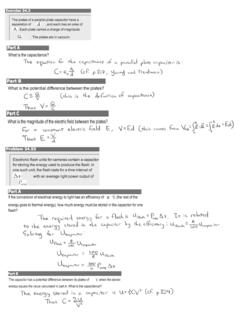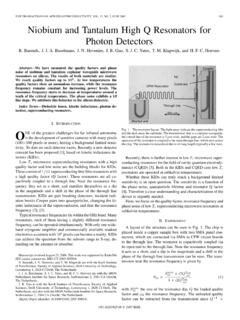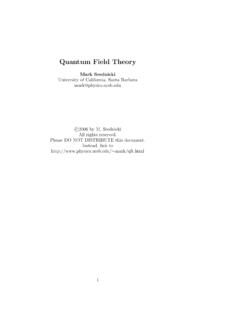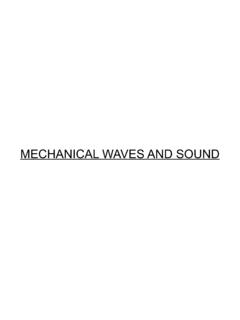Transcription of Introduction to the Physical Properties of Graphene
1 Introduction to the Physical Properties of Graphene Jean-Noe l FUCHS Mark Oliver GOERBIG. Lecture Notes 2008. ii Contents 1 Introduction to carbon Materials 1. The carbon Atom and its Hybridisations .. 3. sp1 hybridisation .. 4. sp2 hybridisation graphitic allotopes .. 6. sp3 hybridisation diamonds .. 9. Crystal Structure of Graphene and graphite .. 10. Graphene 's honeycomb lattice .. 10. Graphene stacking the different forms of graphite .. 13. Fabrication of Graphene .. 16. Exfoliated Graphene .. 16. Epitaxial Graphene .. 18. 2 Electronic Band Structure of Graphene 21. Tight-Binding Model for Electrons on the Honeycomb Lattice 22. Bloch's theorem .. 23. Lattice with several atoms per unit cell .. 24. Solution for Graphene with nearest-neighbour and next- nearest-neighour hopping .. 27. Continuum Limit .. 33. Experimental Characterisation of the Electronic Band Structure 41.
2 3 The Dirac Equation for Relativistic Fermions 45. Relativistic Wave Equations .. 46. Relativistic Schro dinger/Klein-Gordon equation .. 47. Dirac equation .. 49. The 2D Dirac Equation .. 53. Eigenstates of the 2D Dirac Hamiltonian .. 54. Symmetries and Lorentz transformations .. 55. iii iv Physical Consequences of the Dirac Equation .. 61. Minimal length for the localisation of a relativistic par- ticle .. 61. Velocity operator and Zitterbewegung .. 61. Klein tunneling and the absence of backscattering .. 61. Chapter 1. Introduction to carbon Materials The experimental and theoretical study of Graphene , two-dimensional (2D). graphite , is an extremely rapidly growing field of today's condensed matter research. A milestone was the experimental evidence of an unusual quan- tum Hall effect reported in September 2005 by two different groups, the Manchester group led by Andre Geim and a Columbia-Princeton collabora- tion led by Philip Kim and Horst Stormer [1, 2].
3 Since this moment and until March 2008, the beginning of the present series of lectures, almost 700. manuscripts with Graphene in their title have been posted on the preprint server (see Fig. ). The reasons for this enormous scientific interest are manyfold, but one may highlight some major motivations. First, one may emphasise its possible technological potential. One of the first publications on Graphene in 2004 by the Geim group proved indeed the possibility of an electric field effect in Graphene , the possibility to control the carrier density in the Graphene sheet by simple application of a gate voltage [3]. This effect is a fundamental element for the design of electronic devices. Today's silicon-based electronics reaches its limits in miniaturisation, which is on the order of 50 nm for an electric channel, whereas it has been shown that a narrow Graphene strip with a width of only a few nanometers may be used as a transistor [4], the basic electronics component.
4 One may therefore hope to improve the miniaturisation by one order of magnitude when using Graphene -based electronics. Apart from these promising technological applications, two major moti- 1. 2 Introduction to carbon Materials 398. 400. 300. 200 154. 100. 25. before 2006 2007. 2006. Figure : Number of manuscripts with Graphene in the title posted on the preprint server. In interpreting these numbers, one must, however, consider that several publica- tions on Graphene appeared before 2006, in the framework of carbon -nanotube or graphite research. At this moment, the name Graphene was not commonly used. vations for fundamental research may be emphasised. Graphene is the first truely 2D crystal ever observed in nature. This is remarkable because the existence of 2D crystals has often been doubted in the past, namely due to a theorem (Mermin-Wagner theorem) which states that a 2D crystal looses its long-range order, and thus melts, at any small but non-zero temperature, due to thermal fluctuations.
5 Furthermore, electrons in Graphene show rel- ativistic behaviour, and the system is therefore an ideal candidate for the test of quantum-field theoretical models which have been developed in high- energy physics. Most promenently, electrons in Graphene may be viewed as massless charged fermions living in 2D space, particles one usually does not encounter in our three-dimensional world. Indeed, all massless elementary particles happen to be electrically neutral, such as photons or Graphene is therefore an exciting bridge between condensed-matter and high- energy physics, and the research on its electronic Properties unites scientists with various thematic backgrounds. The discussion of Graphene 's electronic Properties and how such relativistic effects are revealed in electric transport measurements is naturally a prominent part of the present lecture notes.
6 The interest in Graphene is not only limited to the scientific community. An important number of large-audience articles have recently been published. The following list of (more or less serious) citations reveals this broad interest 1. The neutrino example is only partially correct. It has been shown that neutrinos must indeed have a tiny non-zero mass. The carbon Atom and its Hybridisations 3. Electrons travel through it so fast that their behaviour is gov- erned by the theory of relativity rather than classical physics.. (The Economist, 2006). Inside every pencil, there is a neutron star waiting to get out.. (New Scientist, 2006). We'll have to rewrite the theory of metals for this problem.. (Physics Today, 2006). Notice that the last citation is from a leading scientist in the field and may indeed serve as a guideline for these The carbon Atom and its Hybridisations carbon , the elementary constituent of Graphene and graphite , is the 6th element of the periodic table.
7 Its atom is, therefore, built from 6 protons, A neutrons, and 6 electrons, where A = 6 and 7 yield the stable isotopes 12. C and 13 C, respectively, and A = 8 characterises the radioactive isotope 14. C. The isotope 12 C, with a nuclear spin I = 0, is the most common one in nature with 99% of all carbon atoms, whereas only 1% are 13 C with a nuclear spin I = 1/2. There are only traces of 14 C (10 12 of all carbon atoms) which -decays into nitrogen 14 N. Although 14 C only occurs rarely, it is an important isotope used for historical dating (radiocarbon). Due to its half-life of 5 700 years, which corresponds to a reasonable time scale in human history, measurement of the 14 C concentration of an organic material, mainly wood, allows one to date its biological activity up to a maximum age of roughly 80 000 years. In general, carbon is the elementary building block of all organic molecules and, therefore, responsible for life on Earth.
8 In the atomic ground state, the 6 electrons are in the configuration 1s2 2s2 2p2 , 2 electrons fill the inner shell 1s, which is close to the nucleus and which is irrelevant for chemical reactions, whereas 4 electrons occupy the outer shell of 2s and 2p orbitals. Because the 2p orbitals (2px , 2py , and 2pz ). are roughly 4 eV higher than the 2s orbital, it is energetically favourable to 2. However, our aim is more modest we do not intend to rewrite but rather to apply . the theory of metals to Graphene . 4 Introduction to carbon Materials ground state excited state ( ~ 4 eV). ~ 4 eV. 2px 2py 2pz 2px 2py 2pz Energy 2s 2s 1s 1s Figure : Electronic configurations for carbon in the ground state (left) and in the excited state (right). put 2 electrons in the 2s orbital and only 2 of them in the 2p orbitals (Fig ). It turns out, however, that in the presence of other atoms, such as H, O, or other C atoms, it is favourable to excite one electron from the 2s to the third 2p orbital, in order to form covalent bonds with the other atoms.
9 The gain in energy from the covalent bond is indeed larger than the 4 eV. invested in the electronic excitation. In the excited state, we therefore have four equivalent quantum-mechanical states, |2si, |2px i, |2py i, and |2pz i. A quantum-mechanical superposition of the state |2si with n |2pj i states is called spn hybridisation, which play an essential role in covalent carbon bonds. sp1 hybridisation In the sp1 hybridisation,3 the |2si state mixes with one of the 2p orbitals. For illustration, we we have chosen the |2px i state. A state with equal weight from both original states, is obtained by the symmetric and anti-symmetric combinations 1 1. |sp+ i = (|2si + |2px i) , |sp i = (|2si |2px i) . 2 2. The other states, |2py i and |2pz i, remain unaffected by this superposition. The electronic density of the hybridised orbitals has the form of a club and 3.
10 The superscript is often omitted, and one may alternatively use sp hybridisation . The carbon Atom and its Hybridisations 5. (a). |2s> |2p x> |sp +>. |2s> |2px > |sp >. (b). 000000000000000 111111111111111. 111111111111111. 111111111111111. 000000000000000 000000000000000. 000000000000000111111111111111. 111111111111111000000000000000. 000000000000000 111111111111111. 111111111111111. 000000000000000. 111111111111111. 000000000000000. 000000000000000. 111111111111111. 000000000000000111111111111111. 000000000000000. 111111111111111. 111111111111111000000000000000. 000000000000000. 111111111111111. 000000000000000 111111111111111. 111111111111111 000000000000000. 000000000000000. 111111111111111. 000000000000000. 111111111111111. 000000000000000. 111111111111111000000000000000. 111111111111111. 000000000000000. 111111111111111 000000000000000111111111111111.







